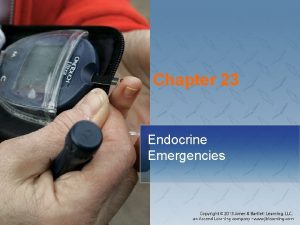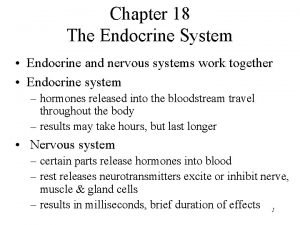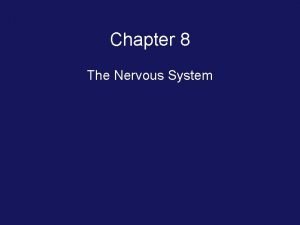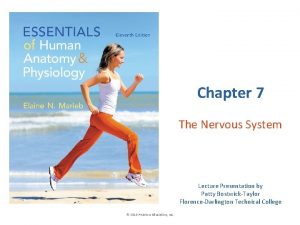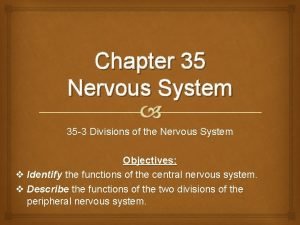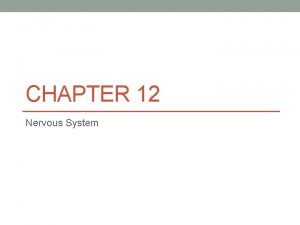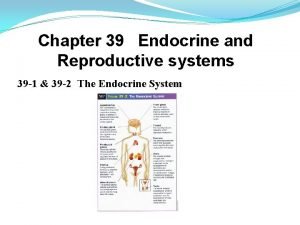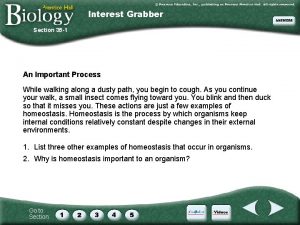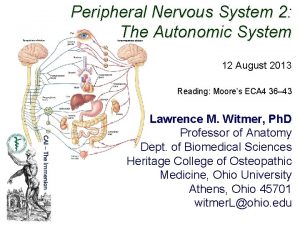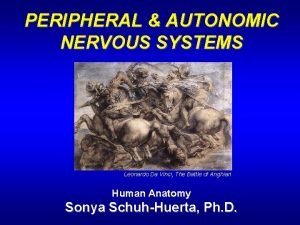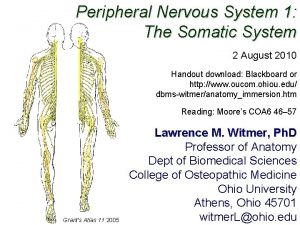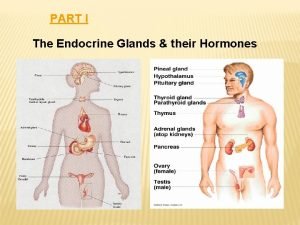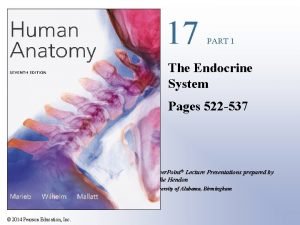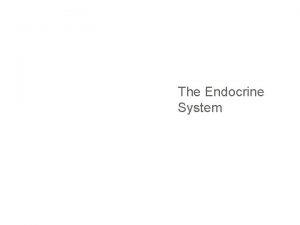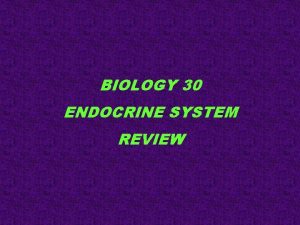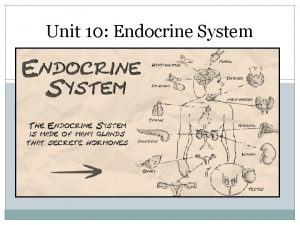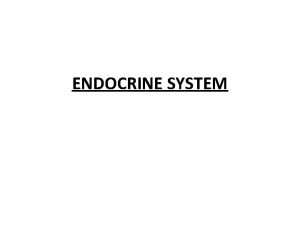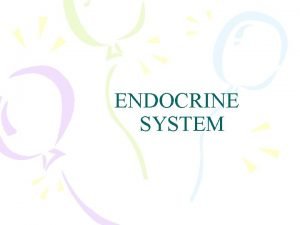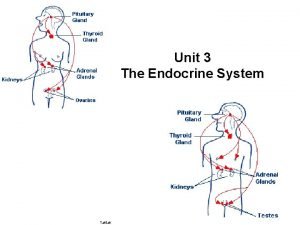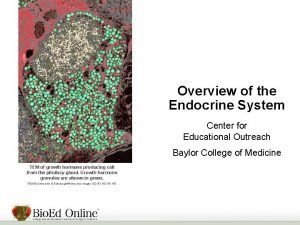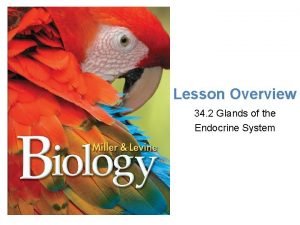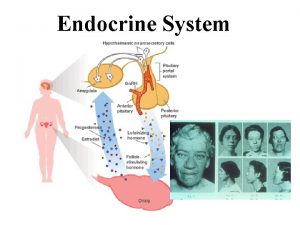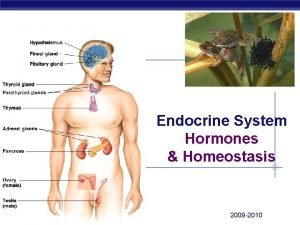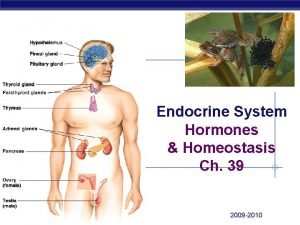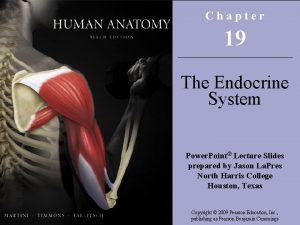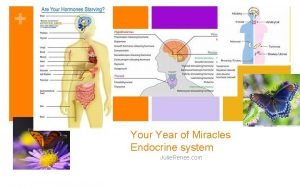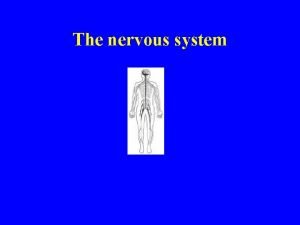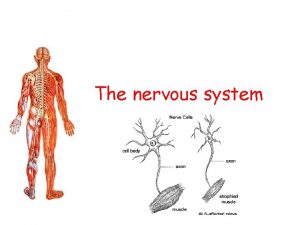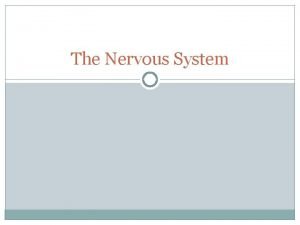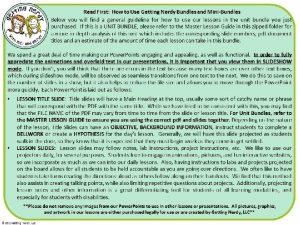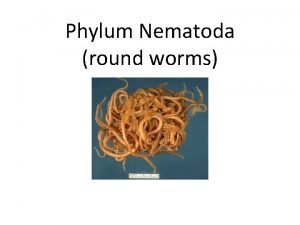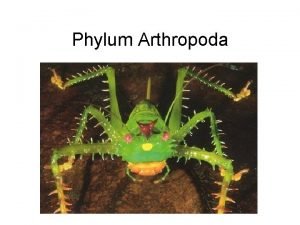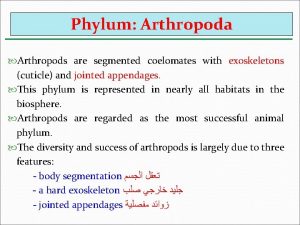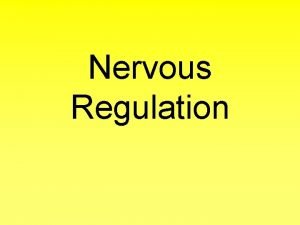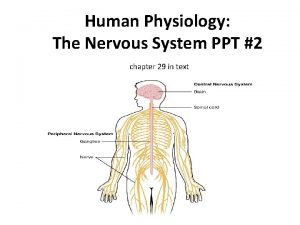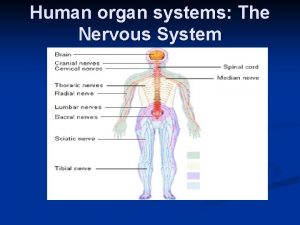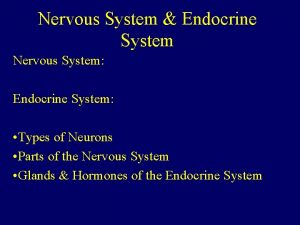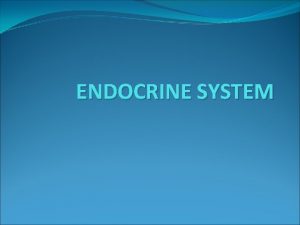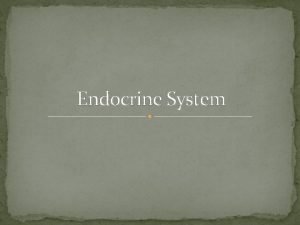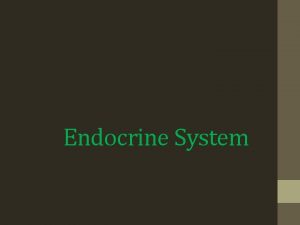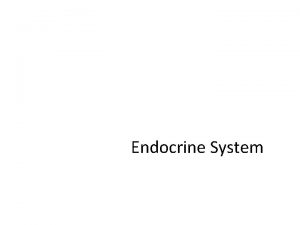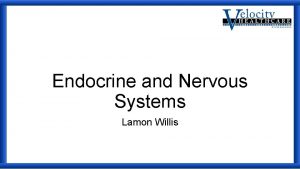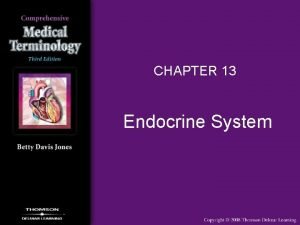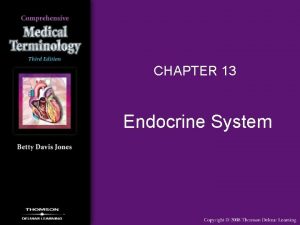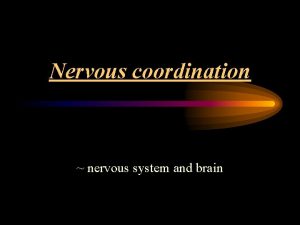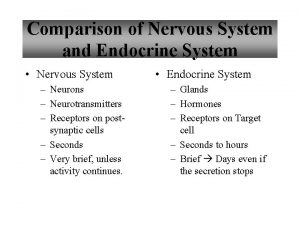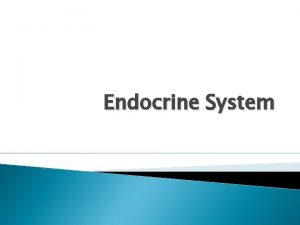Chapter 18 The Endocrine System Endocrine and nervous




















































































- Slides: 84

Chapter 18 The Endocrine System • Endocrine and nervous systems work together • Endocrine system – hormones released into the bloodstream travel throughout the body – results may take hours, but last longer • Nervous system – certain parts release hormones into blood – rest releases neurotransmitters excite or inhibit nerve, muscle & gland cells – results in milliseconds, brief duration of effects 1

General Functions of Hormones • Help regulate: – – extracellular fluid metabolism biological clock contraction of cardiac & smooth muscle – glandular secretion – some immune functions • Growth & development • Reproduction 2

Endocrine Glands Defined • Exocrine glands – secrete products into ducts which empty into body cavities or body surface – sweat, oil, mucous, & digestive glands • Endocrine glands – secrete products (hormones) into bloodstream – pituitary, thyroid, parathyroid, adrenal, pineal – other organs secrete hormones as a 2 nd function • hypothalamus, thymus, pancreas, ovaries, testes, kidneys, stomach, liver, small intestine, skin, heart & placenta 3

Hormone Receptors • Hormones only affect target cells with specific membrane proteins called receptors 4

Role of Hormone Receptors • Constantly being synthesized & broken down • A range of 2000 -100, 000 receptors / target cell • Down-regulation – excess hormone, produces a decrease in number of receptors • receptors undergo endocytosis and are degraded – decreases sensitivity of target cell to hormone • Up-regulation – deficiency of hormone, produces an increase in the number of receptors – target tissue more sensitive to the hormone 5

Blocking Hormone Receptors • Synthetic hormones that block receptors for naturally occurring hormones – RU 486 (mifepristone) binds to the receptors for progesterone preventing it from maintaining the uterus in a pregnant woman • used to induce abortion • brings on menstrual cycle • Hormone is prevented from interacting with its receptors and can not perform its normal functions 6

Circulating & Local Hormones • Circulating hormones – act on distant targets – travel in blood • Local hormones – paracrines act on neighboring cells – autocrines act on same cell that secreted them 7

Lipid-soluble Hormones • Steroids – lipids derived from cholesterol on SER – different functional groups attached to core of structure provide uniqueness • Thyroid hormones – tyrosine ring plus attached iodines are lipid-soluble • Nitric oxide is gas 8

Water-soluble Hormones • Amine, peptide and protein hormones – modified amino acids or amino acids put together – serotonin, melatonin, histamine, epinephrine – some glycoproteins • Eicosanoids – derived from arachidonic acid (fatty acid) – prostaglandins or 9 leukotrienes

Hormone Transport in Blood • Protein hormones circulate in free form in blood • Steroid (lipid) & thyroid hormones must attach to transport proteins synthesized by liver – improve transport by making them water-soluble – slow loss of hormone by filtration within kidney – create reserve of hormone • only. 1 to 10% of hormone is not bound to transport protein = free fraction 10

General Mechanisms of Hormone Action • Hormone binds to cell surface or receptor inside target cell • Cell may then – synthesize new molecules – change permeability of membrane – alter rates of reactions • Each target cell responds to hormone differently – liver cells---insulin stimulates glycogen synthesis – adipose---insulin stimulates triglyceride synthesis 11

Action of Lipid-Soluble Hormones • Hormone diffuses through phospholipid bilayer & into cell • Binds to receptor turning on/off specific genes • New m. RNA is formed & directs synthesis of new proteins • New protein alters cell’s activity 12

Action of Water-Soluble Hormones • Can not diffuse through plasma membrane • Hormone receptors are integral membrane proteins – act as first messenger • Receptor protein activates G-protein in membrane • G-protein activates adenylate cyclase to convert ATP to c. AMP in 13 the cytosol

Water-soluble Hormones (2) • Cyclic AMP is the 2 nd messenger • Activates kinases in the cytosol to speed up/slow down physiological responses • Phosphodiesterase inactivates c. AMP quickly • Cell response is turned off unless new hormone 14 molecules arrive

Second Messengers • Some hormones exert their influence by increasing the synthesis of c. AMP – ADH, TSH, ACTH, glucagon and epinephrine • Some exert their influence by decreasing the level of c. AMP – growth hormone inhibiting hormone • Other substances can act as 2 nd messengers – calcium ions – c. GMP • Same hormone may use different 2 nd messengers 15 in different target cells

Amplification of Hormone Effects • Single molecule of hormone binds to receptor • Activates 100 G-proteins • Each activates an adenylate cyclase molecule which then produces 1000 c. AMP • Each c. AMP activates a protein kinase, which may act upon 1000’s of substrate molecules • One molecule of epinephrine may result in breakdown of millions of glycogen molecules into glucose molecules 16

Cholera Toxin and G Proteins • Toxin is deadly because it produces massive watery diarrhea and person dies from dehydration • Toxin of cholera bacteria causes G-protein to lock in activated state in intestinal epithelium • Cyclic AMP causes intestinal cells to actively transport chloride (Na+ and water follow) into the lumen • Person die unless ions and fluids are replaced & 17 receive antibiotic treatment

Hormonal Interactions • Permissive effect – a second hormone, strengthens the effects of the first – thyroid strengthens epinephrine’s effect upon lipolysis • Synergistic effect – two hormones acting together for greater effect – estrogen & LH are both needed for oocyte production • Antagonistic effects – two hormones with opposite effects – insulin promotes glycogen formation & glucagon stimulates glycogen breakdown 18

Control of Hormone Secretion • Regulated by signals from nervous system, chemical changes in the blood or by other hormones • Negative feedback control (most common) – decrease/increase in blood level is reversed • Positive feedback control – the change produced by the hormone causes more hormone to be released • Disorders involve either hyposecretion or hypersecretion of a hormone 19

Negative Feedback Systems • Decrease in blood levels • Receptors in hypothalamus & thyroid • Cells activated to secrete more TSH or more T 3 & T 4 • Blood levels increase 20

Positive Feedback • Oxytocin stimulates uterine contractions • Uterine contractions stimulate oxytocin release 21

Hypothalamus and Pituitary Gland • Both are master endocrine glands since their hormones control other endocrine glands • Hypothalamus is a section of brain above where pituitary gland is suspended from stalk • Hypothalamus receives input from cortex, thalamus, limbic system & internal organs • Hypothalamus controls pituitary gland with 9 different releasing & inhibiting hormones 22

Anatomy of Pituitary Gland • Pea-shaped, 1/2 inch gland found in sella turcica of sphenoid • Infundibulum attaches it to brain • Anterior lobe = 75% develops from roof of mouth • Posterior lobe = 25% – ends of axons of 10, 000 neurons found in hypothalamus – neuroglial cells called pituicytes 23

Flow of Blood to Anterior Pituitary • Controlling hormones enter blood • Travel through portal veins • Enter anterior pituitary at capillaries 24

Human Growth Hormone • Produced by somatotrophs • Within target cells increases synthesis of insulinlike growth factors that act locally or enter bloodstream – common target cells are liver, skeletal muscle, cartilage and bone – increases cell growth & cell division by increasing their uptake of amino acids & synthesis of proteins – stimulate lipolysis in adipose so fatty acids used for ATP – retard use of glucose for ATP production so blood glucose levels remain high enough to supply brain 25

Regulation of h. GH • Low blood sugar stimulates release of GNRH from hypothalamus – anterior pituitary releases more h. GH, more glycogen broken down into glucose by liver cells • High blood sugar stimulates release of GHIH from hypothalamus – less h. GH from anterior pituitary, glycogen does not breakdown into glucose 26

Diabetogenic Effect of Human Growth Hormone • Excess of growth hormone – raises blood glucose concentration – pancreas releases insulin continually – beta-cell burnout • Diabetogenic effect – causes diabetes mellitis if no insulin activity can occur eventually 27

Thyroid Stimulating Hormone (TSH) • Hypothalamus regulates thyrotroph cells • Thyrotroph cells produce TSH • TSH stimulates the synthesis & secretion of T 3 and T 4 • Metabolic rate stimulated 28

Follicle Stimulating Hormone (FSH) • Releasing hormone from hypothalamus controls gonadotrophs • Gonadotrophs release follicle stimulating hormone • FSH functions – initiates the formation of follicles within the ovary – stimulates follicle cells to secrete estrogen – stimulates sperm production in testes 29

Luteinizing Hormone (LH) • Releasing hormones from hypothalamus stimulate gonadotrophs • Gonadotrophs produce LH • In females, LH stimulates – secretion of estrogen – ovulation of 2 nd oocyte from ovary – formation of corpus luteum – secretion of progesterone • In males, stimulates interstitial cells to secrete testosterone 30

Prolactin (PRL) • Hypothalamus regulates lactotroph cells • Lactotrophs produce prolactin • Under right conditions, prolactin causes milk production • Suckling reduces levels of hypothalamic inhibition and prolactin levels rise along with milk production • Nursing ceases & milk production slows 31

Adrenocorticotrophic Hormone • Hypothalamus releasing hormones stimulate corticotrophs • Corticotrophs secrete ACTH & MSH • ACTH stimulates cells of the adrenal cortex that produce glucocorticoids 32

Melanocyte-Stimulating Hormone • Secreted by corticotroph cells • Releasing hormone from hypothalamus increases its release From the anterior pituitary • Function not certain in humans (increase skin pigmentation in frogs ) 33

Posterior Pituitary Gland (Neurohypophysis) • Does not synthesize hormones • Consists of axon terminals of hypothalamic neurons • Neurons release two neurotransmitters that enter capillaries – antidiuretic hormone – oxytocin 34

Oxytocin • Two target tissues both involved in neuroendocrine reflexes • During delivery – baby’s head stretches cervix – hormone release enhances uterine muscle contraction – baby & placenta are delivered • After delivery – suckling & hearing baby’s cry stimulates milk ejection – hormone causes muscle contraction & milk ejection 35

Oxytocin during Labor • Stimulation of uterus by baby • Hormone release from posterior pituitary • Uterine smooth muscle contracts until birth of baby • Baby pushed into cervix, increase hormone release • More muscle contraction occurs • When baby is born, positive feedback ceases 36

Antidiuretic Hormone (ADH) • Known as vasopressin • Functions – decrease urine production – decrease sweating – increase BP 37

Regulation of ADH • Dehydration – ADH released • Overhydration – ADH inhibited 38

Thyroid Gland • On each side of trachea is lobe of thyroid • Weighs 1 oz & has rich blood supply 39

Histology of Thyroid Gland • Follicle = sac of stored hormone (colloid) surrounded by follicle cells that produced it – T 3 & T 4 • Inactive cells are short • In between cells called parafollicular cells – produce calcitonin 40

Photomicrograph of Thyroid Gland 41

• • • Formation of Thyroid Hormone Iodide trapping by follicular cells Synthesis of thyroglobulin (TGB) Release of TGB into colloid Iodination of tyrosine in colloid Formation of T 3 & T 4 by combining T 1 and T 2 together • Uptake & digestion of TGB by follicle cells • Secretion of T 3 & T 4 into blood 42

Actions of Thyroid Hormones • T 3 & T 4 = thyroid hormones responsible for our metabolic rate, synthesis of protein, breakdown of fats, use of glucose for ATP production • Calcitonin = responsible for building of bone & stops reabsorption of bone (lower 43 blood levels of Calcium)

Control of T 3 & T 4 Secretion • Negative feedback system • Low blood levels of hormones stimulate hypothalamus • It stimulates pituitary to release TSH • TSH stimulates gland to raise blood levels 44

Parathyroid Glands • 4 pea-sized glands found on back of thyroid gland 45

Histology of Parathyroid Gland • Principal cells produce parathyroid hormone (PTH) • Oxyphil cell function is unknown 46

Parathyroid Hormone • Raise blood calcium levels – increase activity of osteoclasts – increases reabsorption of Ca+2 by kidney – inhibits reabsorption of phosphate (HPO 4) -2 – promote formation of calcitriol (vitamin D 3) by kidney which increases absorption of Ca+2 and Mg+2 by intestinal tract • Opposite function of calcitonin 47

Regulation of Calcium Blood Levels • High or low blood levels of Ca+2 stimulate the release of 48 different hormones --- PTH or CT

Adrenal Glands • One on top of each kidney • 3 x 1 cm in size and weighs 5 grams • Cortex produces 3 different types of hormones from 3 zones of cortex • Medulla produces epinephrine & norepinephrine 49

Structure of Adrenal Gland • Cortex derived from mesoderm • Medulla derived from ectoderm 50

Histology of Adrenal Gland • Cortex – 3 zones • Medulla 51

Mineralocorticoids • 95% of hormonal activity due to aldosterone • Functions – increase reabsorption of Na+ with Cl- , bicarbonate and water following it – promotes excretion of K+ and H+ • Hypersecretion = tumor producing aldosteronism – high blood pressure caused by retention of Na+ and water in blood 52

Regulation of Aldosterone 53

Glucocorticoids • 95% of hormonal activity is due to cortisol • Functions = help regulate metabolism – increase rate of protein catabolism & lipolysis – conversion of amino acids to glucose – stimulate lipolysis – provide resistance to stress by making nutrients available for ATP production – raise BP by vasoconstriction – anti-inflammatory effects reduced (skin cream) • reduce release of histamine from mast cells • decrease capillary permeability • depress phagocytosis 54

Regulation of Glucocorticoids • Negative feedback 55

Androgens from Zona Reticularis • Small amount of male hormone produced – insignificant in males – may contribute to sex drive in females – is converted to estrogen in postmenopausal females 56

Adrenal Medulla • Chromaffin cells receive direct innervation from sympathetic nervous system – develop from same tissue as postganglionic neurons • Produce epinephrine & norepinephrine • Hormones are sympathomimetic – effects mimic those of sympathetic NS – cause fight-flight behavior • Acetylcholine increase hormone secretion by 57 adrenal medulla

Anatomy of Pancreas • Organ (5 inches) consists of head, body & tail • Cells (99%) in acini produce digestive enzymes 58 • Endocrine cells in pancreatic islets produce hormones

Cell Organization in Pancreas • Exocrine acinar cells surround a small duct 59 • Endocrine cells secrete near a capillary

Histology of the Pancreas • 1 to 2 million pancreatic islets • Contains 4 types of endocrine cells 60

Cell Types in the Pancreatic Islets • • Alpha cells (20%) produce glucagon Beta cells (70%) produce insulin Delta cells (5%) produce somatostatin F cells produce pancreatic polypeptide 61

Regulation of Glucagon & Insulin Secretion • Low blood glucose stimulates release of glucagon • High blood glucose stimulates secretion of insulin 62

Ovaries and Testes • Ovaries – estrogen, progesterone, relaxin & inhibin – regulate reproductive cycle, maintain pregnancy & prepare mammary glands for lactation • Testes – produce testosterone – regulate sperm production & 2 nd sexual characteristics 63

Pineal Gland • Small gland attached to 3 rd ventricle of brain • Consists of pinealocytes & neuroglia • Melatonin responsible for setting of biological clock • Jet lag & SAD treatment is bright light 64

Effect of Light on Pineal Gland • Melatonin secretion producing sleepiness occurs during darkness due to lack of stimulation from 65 sympathetic ganglion

Seasonal Affective Disorder and Jet Lag • Depression that occurs during winter months when day length is short • Due to overproduction of melatonin • Therapy – exposure to several hours per day of artificial light as bright as sunlight – speeds recovery from jet lag 66

Thymus Gland • Important role in maturation of T cells • Hormones produced by gland promote the proliferation & maturation of T cells – thymosin – thymic humoral factor – thymic factor – thymopoietin 67

Miscellaneous Hormones Eicosanoids • Local hormones released by all body cells • Leukotrienes influence WBCs & inflammation • Prostaglandins alter – smooth muscle contraction, glandular secretion, blood flow, platelet function, nerve transmission, metabolism etc. • Ibuprofen & other nonsteroidal anti-inflammatory drugs treat pain, fever & inflammation by inhibiting prostaglandin synthesis 68

Nonsteroidal Anti-inflammatory Drugs • Answer to how aspirin or ibuprofen works was discovered in 1971 – inhibit a key enzyme in prostaglandin synthesis without affecting the synthesis of leukotrienes • Treat a variety of inflammatory disorders – rheumatoid arthritis • Usefulness of aspirin to treat fever & pain implies prostaglandins are responsible for those symptoms 69

Growth Factors • Substances with mitogenic qualities – cause cell growth from cell division • Many act locally as autocrines or paracrines • Selected list of growth factors (Table 18. 12) – epidermal growth factor – platelet-derived growth factor – fibroblast growth factor – nerve growth factor – tumor angiogenesis factors – transforming growth factors 70

Stress & General Adaptation Syndrome • Stress response is set of bodily changes called general adaptation syndrome (GAS) • Any stimulus that produces a stress response is called a stressor • Stress resets the body to meet an emergency – eustress is productive stress & helps us prepare for certain challenges – distress type levels of stress are harmful • lower our resistance to infection 71

General Adaptation Syndrome 72

Alarm Reaction (Fight-or-Flight) • Initiated by hypothalamic stimulation of sympathetic portion of the ANS & adrenal medulla • Dog attack – increases circulation – promotes ATP synthesis – nonessential body functions are inhibited • digestive, urinary & reproductive 73

Resistance Reaction • Initiated by hypothalamic releasing hormones (long-term reaction to stress) – corticotropin, growth hormone & thyrotropin releasing hormones • Results – increased secretion of aldosterone acts to conserve Na+ (increases blood pressure) and eliminate H+ – increased secretion of cortisol so protein catabolism is increased & other sources of glucose are found – increase thyroid hormone to increase metabolism • Allow body to continue to fight a stressor 74

Exhaustion • Resources of the body have become depleted • Resistance stage can not be maintained • Prolonged exposure to resistance reaction hormones – wasting of muscle – suppression of immune system – ulceration of the GI tract – failure of the pancreatic beta cells 75

Stress and Disease • Stress can lead to disease by inhibiting the immune system – hypertension, asthma, migraine, gastritis, colitis, and depression • Interleukin - 1 is secreted by macrophages – link between stress and immunity – stimulates production of immune substances – feedback control since immune substance suppress the formation of interleukin-1 76

Development of the Endocrine System • Thyroid develops ---floor of pharynx 2 nd pouch • Parathyroid & thymus --3 & 4 pharyngeal pouches 77 • Pancreas from foregut

Development of Pituitary Gland • Events occurring between 5 and 16 weeks of age 78

Aging and the Endocrine System • Production of human growth hormone decreases – muscle atrophy • Production of TSH increase with age to try and stimulate thyroid – decrease in metabolic rate, increase in body fat & hypothyroidism • • Thymus after puberty is replaced with adipose Adrenal glands produce less cortisol & aldosterone Receptor sensitivity to glucose declines Ovaries no longer respond to gonadotropins – decreased output of estrogen (osteoporosis & atherosclerosis) 79

Pituitary Gland Disorders • Hyposecretion during childhood = pituitary dwarfism (proportional, childlike body) • Hypersecretion during childhood = giantism – very tall, normal proportions • Hypersecretion as adult = acromegaly – growth of hands, feet, facial features & thickening of skin 80

Thyroid Gland Disorders • Hyposecretion during infancy results in dwarfism & retardation called cretinism • Hypothyroidism in adult produces sensitivity to cold, low body temp. weight gain & mental dullness • Hyperthyroidism (Grave’s disease) – weight loss, nervousness, tremor & exophthalmos (edema behind eyes) • Goiter = enlarged thyroid (dietary) 81

Cushing’s Syndrome • Hypersecretion of glucocorticoids • Redistribution of fat, spindly arms & legs due to muscle loss • Wound healing is poor, bruise easily 82

Addison’s disease • Hypersecretion of glucocorticoids – hypoglycemia, muscle weakness, low BP, dehydration due to decreased Na+ in blood – mimics skin darkening effects of MSH – potential cardiac arrest 83

Diabetes Mellitus & Hyperinsulinism • Diabetes mellitus marked by hyperglycemia – excessive urine production (polyuria) – excessive thirst (polydipsia) – excessive eating (polyphagia) • Type I----deficiency of insulin (under 20) • Type II---adult onset – drug stimulates secretion of insulin by beta cells – cells may be less sensitive to hormone 84
 Endocrine system and nervous system
Endocrine system and nervous system Endocrine system and nervous system
Endocrine system and nervous system General mechanism of hormone action
General mechanism of hormone action Differences between nervous system and endocrine
Differences between nervous system and endocrine Comparison of endocrine and nervous system
Comparison of endocrine and nervous system Endocrine and nervous system comparison
Endocrine and nervous system comparison Neuron process
Neuron process Nervous
Nervous Neuron processes
Neuron processes Endocrine system and reproductive system
Endocrine system and reproductive system Calcitonin and pth are antagonistic hormones
Calcitonin and pth are antagonistic hormones Hormones
Hormones Nervous system and digestive system
Nervous system and digestive system Chapter 15 nervous system diseases and disorders
Chapter 15 nervous system diseases and disorders Lympathic
Lympathic Chapter 16 endocrine system
Chapter 16 endocrine system Chapter 7 13 endocrine system
Chapter 7 13 endocrine system Endocrine glands
Endocrine glands Chapter 23 the endocrine system
Chapter 23 the endocrine system Unit 6 human development lesson 1 pregnancy
Unit 6 human development lesson 1 pregnancy Lipid soluble hormones examples
Lipid soluble hormones examples Componentes componentes
Componentes componentes Chapter 8 the nervous system
Chapter 8 the nervous system Chapter 7 the nervous system figure 7-2
Chapter 7 the nervous system figure 7-2 Chapter 35 nervous system
Chapter 35 nervous system Chapter 14 lesson 3 the nervous system
Chapter 14 lesson 3 the nervous system Chapter 12 nervous system
Chapter 12 nervous system Chapter 46 digestive and endocrine disorders
Chapter 46 digestive and endocrine disorders Section 39-4 fertilization and development
Section 39-4 fertilization and development Chapter 29 endocrine and metabolic disorders
Chapter 29 endocrine and metabolic disorders Chapter 19 endocrine and hematologic emergencies
Chapter 19 endocrine and hematologic emergencies Section 35-5 drugs and the nervous system answer key
Section 35-5 drugs and the nervous system answer key Difference between sympathetic and parasympathetic
Difference between sympathetic and parasympathetic Sympathetic and parasympathetic nervous system difference
Sympathetic and parasympathetic nervous system difference Division of nervous system
Division of nervous system Arthropod nervous system
Arthropod nervous system Brain and spinal cord nervous system
Brain and spinal cord nervous system Nervous system chart
Nervous system chart Autonomic nervous system pathway
Autonomic nervous system pathway Parts of the endocrine system
Parts of the endocrine system Gonads glands
Gonads glands Endocrine system fact
Endocrine system fact Rat appendix
Rat appendix Humoral neural and hormonal stimuli
Humoral neural and hormonal stimuli Stimulus endocrine system
Stimulus endocrine system Humoral stimulus
Humoral stimulus Biology 30 endocrine system
Biology 30 endocrine system Chromaffin cells
Chromaffin cells Endocrine system analogy
Endocrine system analogy Introduction of endocrine system
Introduction of endocrine system Endocrine system abbreviations
Endocrine system abbreviations T4.taktak
T4.taktak Endocrine system
Endocrine system Classification of hormone
Classification of hormone Pancreas in endocrine system
Pancreas in endocrine system Glands of the endocrine system
Glands of the endocrine system Endocrine system
Endocrine system Endocrine system regents questions
Endocrine system regents questions Endocrine system regents questions
Endocrine system regents questions Pearson endocrine system
Pearson endocrine system Testacies
Testacies Chemical messengers of the nervous system
Chemical messengers of the nervous system Worms phylum
Worms phylum The nervous system is made up of
The nervous system is made up of Primary functions of the nervous system
Primary functions of the nervous system Nervous system learning objectives
Nervous system learning objectives Stimulus in nervous system
Stimulus in nervous system Neuron bundle
Neuron bundle Nerve ganglia
Nerve ganglia Autonomic nervous system def
Autonomic nervous system def 31 pairs of spinal nerves
31 pairs of spinal nerves Sns pg
Sns pg The nervous system brain scienstructable
The nervous system brain scienstructable Somatic vs autonomic nervous system
Somatic vs autonomic nervous system Phylum
Phylum Arthro drama
Arthro drama Jointed foot phylum
Jointed foot phylum Segmented coelomates
Segmented coelomates Parasympathatic
Parasympathatic Nervous system in coelenterata
Nervous system in coelenterata Autonomic nervous system consists of
Autonomic nervous system consists of Human nervous system ppt
Human nervous system ppt Basic unit of nervous system
Basic unit of nervous system What is a pathogen
What is a pathogen Histology of nervous system ppt
Histology of nervous system ppt


















